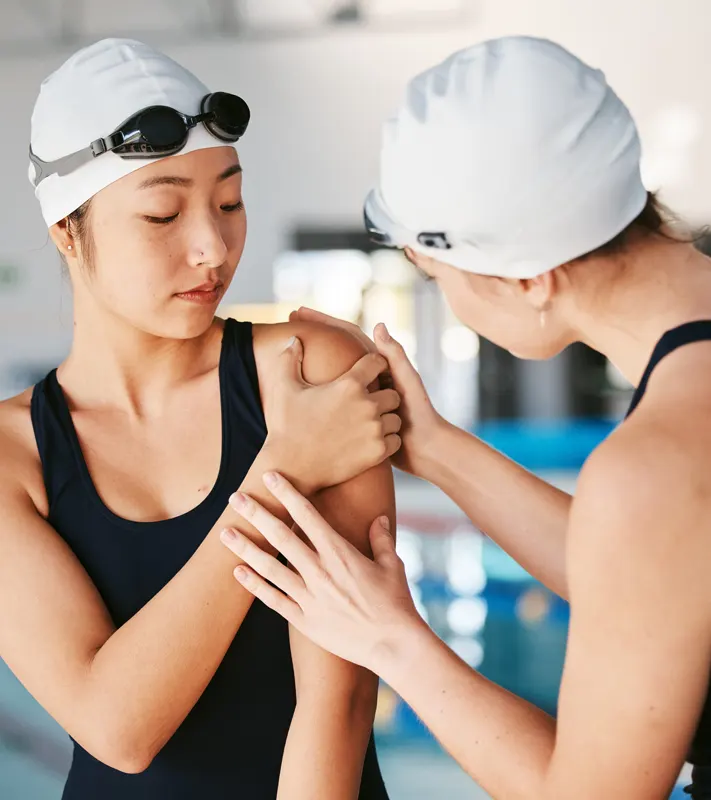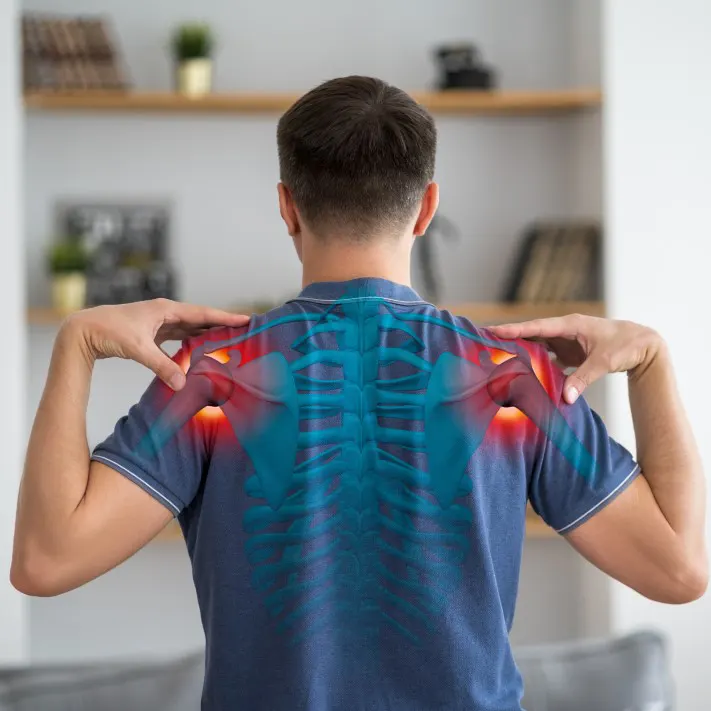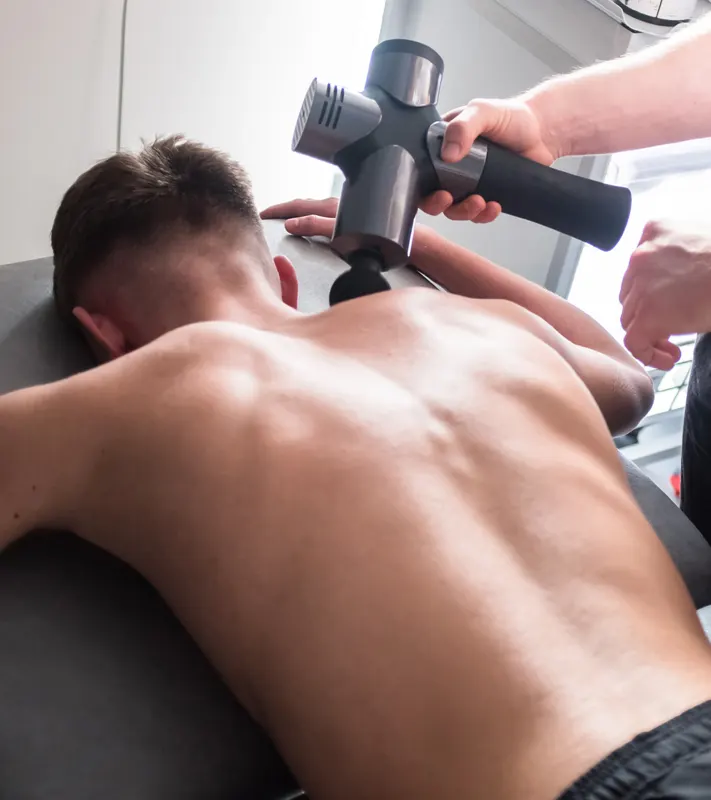What is Shoulder Pain?
Shoulder pain is most commonly connected to overuse activities, but is also associated with acute injuries, poor body mechanics, damaged nerves, and age-related issues like arthritis. Depending on your condition and personal tolerance, your shoulder pain may vary in level of discomfort. It can range from slight soreness, to numbness and tingling, reaching all the way to an extreme burning and stabbing pain. Pain may be localized or radiate to the neck, the upper back, or the outside of the upper arm. Physical Therapy is an effective shoulder pain treatment that can be used to reduce pain and restore range of motion.
Understanding Shoulder Anatomy
The shoulder is a ball and socket joint, also known as the glenohumeral joint, and is the body’s most flexible and complex joint. It is the connection of the scapula (shoulder blade) with the humerus (upper arm), but also incorporates the motion between the shoulder blade and the upper back. With so much mobility, it is no surprise that the shoulder is prone to injury.
Causes of Shoulder Pain
Shoulder pain is frequently linked to the activities we do and how we perform them. Below are some common causes of shoulder pain, as well as other activities that may contribute to shoulder discomfort or dysfunction:
- Acute injuries to the shoulder, such as falls or car accidents
- Jobs that require heavy lifting and/or repetitive arm movement (manufacturing, retail, construction, janitorial, extended computer use, etc.)
- Sports such as baseball, football, tennis, gymnastics, climbing, swimming, and bowling
- Overuse activities that require constant, overhead, and/or repetitive motion of the arm (gardening, painting, driving, crafting, etc.)
- Lack of upper body strength and conditioning
- Poor posture/ergonomics
- Pinched or damaged nerves
- Inflammation
- Advanced age

Shoulder Pain Conditions
SportsCare Physical Therapists are experts in shoulder physical therapy. Our PT’s offer shoulder pain treatment to rehabilitate a variety conditions, including, but not limited to:
- Acromioclavicular joint (AC Joint) injuries
- Joint replacement or reconstruction
- Debridement surgeries
- Shoulder impingement
- Adhesive capsulitis (Frozen Shoulder)
- Shoulder instability (dislocations and separations)
- Labral tears
- Rotator cuff tears
- Rotator cuff tendonitis
- Bicep tendonitis
- Osteoarthritis, bursitis

Shoulder Pain Treatment
SportsCare Physical Therapy sees each patient as an individual with unique needs. At your evaluation appointment, your physical therapist will perform a professional assessment of your injury or condition. Together you will discuss your recovery goals and they will answer any questions about the PT process that you may have. Next, your physical therapist will create a personalized shoulder pain treatment plan specifically for your needs. Shoulder physical therapy at SportsCare may include:
- Manual Therapy
- Therapeutic Exercises
- Education for injury prevention
- Home Exercise Program
- Extracorporeal shockwave therapy
- Traction
- Aquatic Pool Therapy
- Intermittent Compression with Cold (Game Ready and Normatec)
- Electrical stimulation, ultrasound, andcold/heat modalities
- Kinesio Tape
- Joint Mobilization/Stabilization
- Blood Flow Restriction (BFR) Training

Frequently Asked Questions
-
How will my shoulder pain symptoms progress?
Shoulder pain can take some time for it to start to decrease. Muscles and tendons generally take 4-6 weeks to heal, and physical therapy can improve the length and intensity of your symptoms.
-
When should I seek shoulder pain treatment?
If your shoulder pains do not start to show improvement in the first few weeks after injury, then starting physical therapy early can help to get the muscles healing quickly to decrease your pain and get you back to the activities you love to do.
-
How long will shoulder physical therapy typically last?
Physical therapy can last a few weeks to months depending on the injury and severity of your symptoms. The length of time you have been having pain can also play a role in how quickly your body will recover.
-
When can I return to work after beginning shoulder pain treatment?
Usually, you will be able to return to work quickly with modifications, and a full return as your shoulder fully recovers. Ultimately, your workers’ compensation injury provider will determine when and at what capacity you can return to work.
-
When can I return to playing sports after a shoulder injury?
Being able to return to sports may take several weeks until your shoulder pain starts to decrease. Your PT may also suggest you make a gradual return to full participation to make sure that you do not re-injure your shoulder.
-
How can I sleep with shoulder pain?
Sleeping with shoulder pain can be challenging, and many times the use of extra pillows or in some cases sleeping in a recliner may be the best solution. Your physical therapist will be able to make suggestions on positions that will help you get the sleep and rest you need.
-
Does SportsCare take my insurance?
Here is a list of the insurance plans accepted by SportsCare Physical Therapy and Armworks Hand Therapy. If you are unsure of your coverage or if your plan is accepted, please contact one of our offices. We are happy to assist you in learning about your benefits.
-
Where is SportsCare Physical Therapy located?
SportsCare Physical Therapy has offices in Gresham, Sandy, NE Portland, Clackamas, Beaverton, and Salem. For location specific contact information click here.
